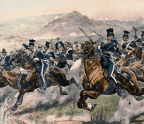THE CRUCIBLE OF ANTIOCH

As the Bridge Gate of Antioch swung open on June 28, 1098, arrows rained down on the grimly determined Christian column advancing out of the city. These soldiers of the First Crusade had besieged Muslim-held Antioch for more than seven months before finally taking the city, only to be immediately besieged themselves by a massive Muslim army. Within a month, facing defeat through starvation, their leaders had decided to venture outside the walls and do battle. Conquer or die, the coming confrontation would mark the final act in the saga of the conquest of Antioch.


Following a series of disastrous reversals in Asia Minor (present-day eastern and central Turkey) between 1091 and 1095, the Byzantine empire faced an existential threat: The Seljuk Turks, recent converts to Islam, had advanced to within 50 miles of the Byzantine capital of Constantinople. Emperor Alexius I Comnenus sent a delegation to Pope Urban II in Rome, begging for military support against the Turks. Fortunately for Alexius, Urban and the knights of Western Europe were able and willing to respond. On Nov. 27, 1095, Urban appeared at Clermont in southern France and called on the gathered knights to liberate the Christians of the East and the Holy City of Jerusalem from the Seljuk scourge.
The great army that responded to Urban’s call had coalesced in Constantinople by the spring of 1097. It was organized in four “national” contingents, each under the leadership of its respective lords. From northern and central France came Duke Robert of Normandy, son of William the Conqueror; Count Stephen of Blois and Chartres, one of the Conqueror’s sons-in-law; Count Hugh of Vermandois, younger brother of King Philip of France; and Count Robert of Flanders. From the northern border area between France and Germany came Godfrey of Bouillon, Duke of Lower Lorraine.
From southern France came Raymond of Saint-Gilles, Count of Toulouse, who, being in his mid-50s, was the oldest of the commanders, as well as the wealthiest. Raymond was the first great lord to “take the cross,” and he shared the leadership of his
You’re reading a preview, subscribe to read more.
Start your free 30 days



